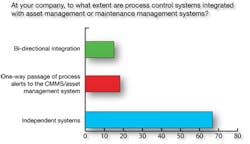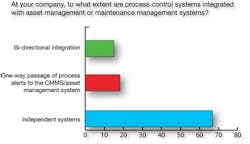PLC Software Tops Usage Survey
PLC programming software was the big winner in Control’s June 2008 Market Intelligence Report on the use of process control software. The report is based on a survey of Control’s readership. More than 300 readers answered questions about the type of software they use, how effectively they use it, and their integration strategies.
The survey covered 12 categories of software: advanced control, alarm management, batch/recipe management, calibration management, design and documentation, loop tuning, maintenance/asset management, manufacturing execution, PLC programming, production planning, SCADA/operator interface and simulation. For each category, respondents were asked to say whether they used it “routinely,” “have installed, but underutilized,” “don’t use, but intend to,” and “don’t intend to use.”
PLC software won because 78% of the respondents say they use it “routinely,” and only 10.9% say they never intend to use it. The other software categories in the top five for routine use were SCADA/operator interface software at 61%, alarm management at 52%, design and documentation at 49% and advanced control software at 43%. At the back of the pack was manufacturing execution system (MES) software with only a little over a quarter (26.4%) of respondents saying they use it, and nearly 40% indicating they don’t intend to.
These numbers bode well for advanced control software. In addition to the 43% who said they use it, 23% said they have the software, but don’t use it as much as they could, and 19% said they plan to use it in the future. That comes to a total of 85%, which is a good sign that automation control professionals still believe in the promise of this technology.
Some of the most interesting numbers come in the “underutilized” and “don’t use” categories. For example, 30% of those who have installed loop-tuning software (36% of the total number surveyed) say they have it installed, but don’t use it as much as they could. Another 20% indicate that they’d like to install it in the future. For design and documentation software, 27% of those who could use it think they don’t use it as well as they should, but less than 10% say they won’t use it at all. A quarter of those who use asset and maintenance management software or simulation software think they don’t use the products to the extent they could.
This survey confirmed the numbers in Control’s earlier survey on calibration software: Survey respondents aren’t in love with it. More than 42% of those surveyed say they don’t use it, and 18% say they don’t plan to.
Figure 1. Our survey respondents are less than enthusiastic about integrating their asset and maintenaince management with their process control systems.
The placement of MES at the bottom is interesting, given the drumbeat among vendors and the press for real-time interconnectivity between manufacturing processes and the enterprise layer. Less than 27% of those surveyed use MES routinely, compared to 42% of users who reported using production-planning software, and an additional 46% saying they either underutilized it or were not intending to use it. In short, 89% of the respondents believe in production planning, but 39.5% don’t believe in MES integration.
PLCs, Yes; Integration, Not So Much
Similar to the calibration software usage numbers, those for integration indicate that integration is far more popular with vendors and in the press than in practice.
Two-thirds of those surveyed say they have stand-alone process control assets and maintenance management systems that have no easy way to pass information between them. The answers also contain good news for systems integrators. Just over one-third say they use OPC for integration, but almost 20% say, “We don’t know or care. We call our system integrator.”
Furthermore, in spite of the vendor push about web services and XML to make data easily transferable, fewer than 7% of users use this methodology, while 16% are still developing their own custom drivers.
Business Intelligence—Not Yet
Respondents to the survey also are underwhelmed by business intelligence (BI) software, which we described as, “a class of data analysis, reporting and query tools designed to address specific business/performance issues.” The survey asked about decision support, KPI reporting, quality analysis, production analysis, regulatory compliance and role-based dashboard software.
Perhaps not surprisingly, applications that support regulatory compliance were the most used, with 43% of respondents saying they use it routinely, and another 15% saying they don’t use it as much as they could. The other 42% were evenly split between those who intend to install such apps and those who don’t.
Quality and production analysis applications came in second with 37% of those surveyed saying they’re using them routinely and another 28% reporting they have the software, but don’t use it to the fullest.
Software to measure that darling of the analysts, KPIs, is actually used by only about a third of respondents, although another 27% have it installed, but don’t use it as much as they could.
The big losers in the BI category are decision-support systems and role-based dashboards. Close to 30% of respondents say they don’t intend to use decision-support systems, and 40% say the same thing about dashboards. What is not clear from our analysis is whether these naysayers don’t understand the value of these systems, or whether they do understand them and choose not to use them anyway.


